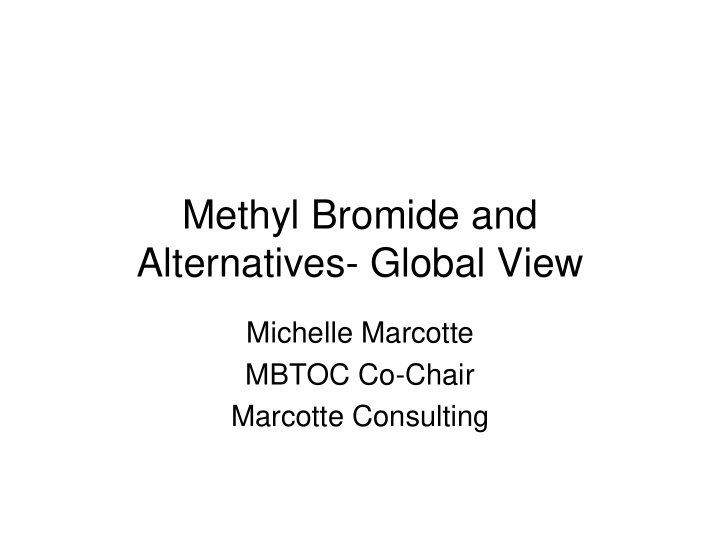



Methyl Bromide and Alternatives- Global View Michelle Marcotte MBTOC Co-Chair Marcotte Consulting
Overview • Montreal Protocol – How the decisions of 189 countries became significant to the business decisions of US mills and processors • How the recommendations of a small band of scientists and technical experts (MBTOC) also affect your business • Four new issues that might negotiators • How to make decisions that will sustain your business in spite of the above
Montreal Protocol on Ozone Depleting Substances • Protecting the ozone layer by phasing out ozone depleting substances • “The single most successful international environmental agreement to date” (Kofi Annan) • 195 of 196 UN nations are signatories • 2005 was the phase out date for MB
Methyl Bromide Technical Options Committee (MBTOC) • MBTOC is a technical and economic options committee; part of the Technical and Economic Panel of the Montreal Protocol • Divided into sub-committees: Soils (preplant issues) and Quarantine, Structures and Commodities (QSC) • QSC covers all post-harvest issues • QSC 19 members; 15 countries
MBTOC’s Tasks • Technical and economic assessment of alternatives to all uses of methyl bromide • Review and recommendations on critical use nominations received from Parties • Policy relevant advice to Parties concerning remaining MB uses: critical, quarantine and pre-shipment • Numerous technical reports
MB Global Consumption 1991-2007 60,000 Baseline Non-Article 5 Baseline Article 5 50,000 M B consumption Non-Article 5 MB consumption (metric tonnes) 40,000 M B consumption Article 5 30,000 Consumption 2007 20,000 Non A5 - 6,000 t 10,000 A5 - 6,146 t (approx.) 0 1991 1992 1993 1994 1995 1996 1997 1998 1999 2000 2001 2002 2003 2004 2005 2006 2007 Note: Reported Production for QPS Uses in 2006 - 10,275 t (approx)
Production and Consumption of QPS MB Global production vs global consumption of MB for QPS uses 16000 14000 MB (metric tonnes) 12000 10000 Production 8000 Consumption 6000 4000 2000 0 1999 2000 2001 2002 2003 2004 2005 2006 2007 Year
MB Use for QPS Global MB use categories for QPS purposes Fruit & veg 1% 3% Grain 3% 2% 8% 1% WPM 2% Wood 3% 15% Logs Soil in situ Dried foodstuffs 18% Cut flowers & bulbs Equipm ent 16% Undefined Misc 2% Seeds 26% Other
Montreal Protocol Decision IX/6 Critical Use Nominations only apply after 100% phase out Use of MB should qualify as "critical" only if • a) the lack of MB would result in significant market disruption; and • b) there are no technically and economically feasible and suitable alternatives Critical MB use permitted only if: • Minimize use and reduce emissions, • MB not available from stocks, • Efforts to evaluate and adopt alternatives, • Research effort
Structural Critical Use Nominations • This slide deliberately left blank until workshop
Trend in MB use Food Processing and Milling All Food Processing and Milling (Not Commodities) 600 500 Belgium 400 Canada France metric tonnes Germany 300 Greece Israel Italy UK 200 USA 100 0 2006 2007 2008 2009 2010 2011 Year
Commodity CUN Applications • Commodities (2005 CUNs) • Nuts: pistachio, walnut, almond • Chestnuts • Commodities (2009 CUNs) • Cocoa beans • Walnuts • Coffee beans • Chestnuts • Cheese • Dry beans • Cheese • Dry cure pork • Dry beans • Dried fruit (dates, figs, prunes, • Dry cure pork raisins) • Dried fruit (dates, prunes, • Herbs and spices raisins) • Dried milk • Medicinal herbs and • Rice mushrooms • Museum artifacts • Strawberry plantlets • Seeds for planting • Rice • Electronic equipment • baskets
Stocks of MB held by Party - Consideration of Stocks (Dec IX/6 1,bii) MBTOC has not accounted for stocks when evaluating CUNs Quantity of MB stocks at end of year as reported by the Party 2007 2008 Australia 0.000 0.000 Canada 0.348 1.997 EC 8.446 0.092 Israel 190.450 190.450 Japan 17.594 7.524 New Zealand 0.000 0.000 USA 6503.000* 5381.000* Total 6719.838 5650 * Includes the pre-2005 stocks
GWP of Sulfuryl Fluoride • Sulfuryl fluoride (SF), has recently been reported to have a higher global warming potential (GWP) than previously considered • The “most likely” GWP for SF of about 4,800, a value similar to that of CFC-11 • See MBTOC QSC Progress report for refs
EU Elimination of MB for QPS • Regulations in Holland and Belgium required that 80% of remaining MB in export containers be recaptured • German ports were also installing recapture equipment • BUT, as of March 2010, the use of MB for QPS in the EU is eliminated • Result is likely to be more MB QPS use in importing countries and higher pest incursion risk • Importing countries do not now use recapture equipment so emissions of MB likely to be higher globally
MB Producer Issues • Chemtura, the main supplier and distributor of methyl bromide in the US, has filed for Chapter 11 bankruptcy, a legal action which protects assets and allows financial and corporate restructuring for a certain time period • Impact of this on users?? • It can take months to import MB from other countries, and there can be a problem with incompatibility of shipping containers
Making Sustainable Business Decisions in the Face of Global Environmental Agreements • The problems are: • MB CUNs are going to be eliminated, likely through > 25% per year decreases • Tough getting money for investments in pest control • Can’t sell flour with bugs • SF has high GWP and reportedly costs more than MB • Heat treatment also likely higher GWP and reportedly costs more that MB
Pest Control, Stewardship and Messages • Prevention • Low tech choices - going back to the farm • Reduce frequency of full site treatments • Heat treatment – full site or spot heat • SF and heat • Better messages, broader audience, backed up with action
Recommend
More recommend